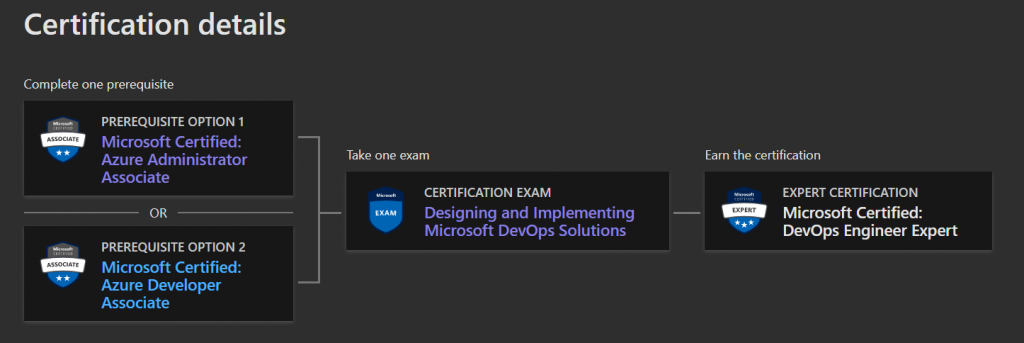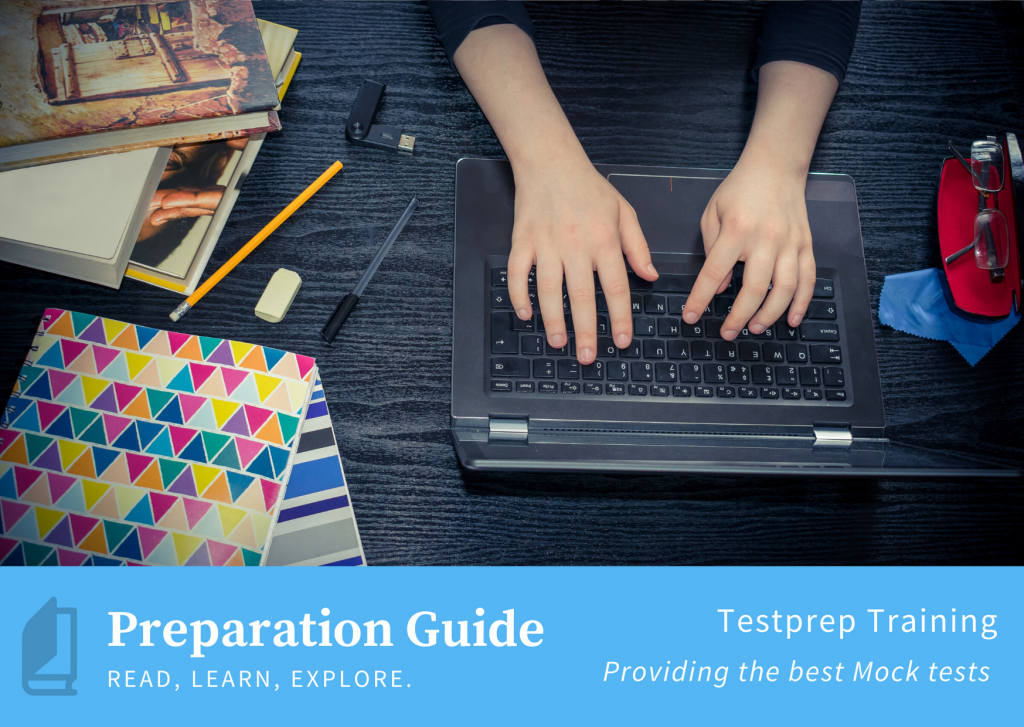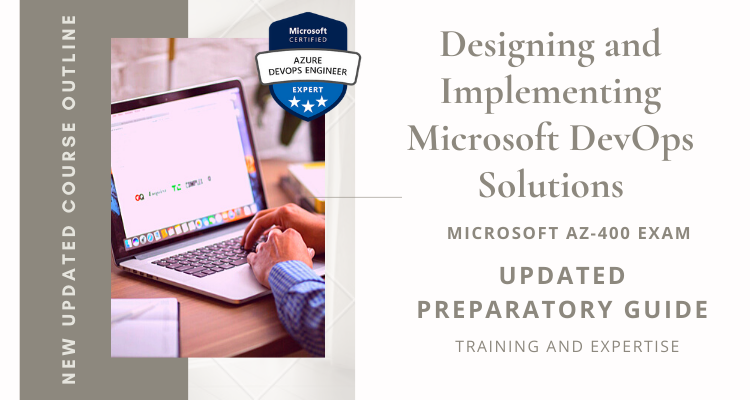Undoubtedly, DevOps is the in-demand professional to begin your career with. Since the implementation of DevOps culture isn’t slowing down anytime soon. So, if you’re wondering how can you become a DevOps engineer? What does a DevOps engineer do? Certainly, Microsoft AZ-400 exam is a good option, to begin with.
If you are an Ops person and would like to explore what DevOps is all about, then AZ-400 exam is “the door” to unlock.
In the same vein, we’re going to provide you with all the details regarding the AZ-400 exam. Also, a preparation guide to follow, making it a cakewalk to qualify for the AZ-400 Microsoft Azure DevOps Solutions exam.
Microsoft AZ-400: An Overview
The Microsoft AZ-400 exam measures candidates ability to design a DevOps strategy. Further, candidate will be able to implement the following :
- First of all, DevOps development processes
- Secondly, dependency management
- Subsequently, application infrastructure
- Also, continuous integration, delivery, and feedback.
Keep in mind that the people taking this exam are DevOps professionals. They’re experts in bringing together people, processes, and technology to consistently provide useful products and services that meet user needs and business goals. These professionals make the delivery process smoother by improving how things are done, improving communication, working together, and using automation.

Additionally, they design and execute strategies for application code and infrastructure. And, further leads to continuous integration, testing, delivery, monitoring, and feedback.
Audience Profile
Whenever you wish to appear for certification, make sure you view the target audience here. This way, you’ll be doubly sure, if you’re the ideal candidate or not. So, here is the list of all the candidates who are eligible for the Microsoft AZ-400 exam.
- Firstly, candidates taking this exam should be experts in working with people, processes, and technology to consistently provide value to businesses.
- Secondly, this exam is suitable for those who are responsible for creating and carrying out plans related to collaboration, code, infrastructure, source control, security, compliance, continuous integration, testing, delivery, monitoring, and feedback.
- Lastly, candidates should have a good understanding of both Azure administration and development and be experts in at least one of these areas.
Basic Details
These may seem like simple details, but they are crucial for your preparation. They give you information about how the exam is set up. So, the AZ-400 exam will have 40-60 questions. These questions can be of multiple-choice or multiple-response types. You need to finish the exam in 150 minutes. Also, the exam is offered in four languages, which are:
- English,
- Japanese,
- Chinese (Simplified),
- Korean
The cost of the AZ-400 exam is $165, plus any extra taxes. Keep in mind that the fee can be different in each country, so it’s a good idea to check the exact cost for your location before registering.

At last, you have understood about the skills required and details of exam pattern. Now, you’re only left with course outline, also known as skills measured.
AZ-400 Course Outline aka Skills measured
Now, let’s focus on the module list, which is incredibly important for the exam. The questions in the exam will come from this list of modules. So, we strongly recommend that you thoroughly understand each and every module. If you have a strong foundation in these modules, you’re more likely to succeed. So, don’t overlook this section under any circumstances.
1. Design and implement processes and communications (10–15%)
Design and implement traceability and flow of work
- Design and implement a structure for the flow of work, including GitHub Flow
- Design and implement a strategy for feedback cycles, including notifications and issues
- Design and implement integration for tracking work, including GitHub projects, Azure Boards, and repositories
- Design and implement source, bug, and quality traceability
Design and implement appropriate metrics and queries for DevOps
- Design and implement a dashboard, including flow of work, such as cycle times, time to recovery, and lead time
- Design and implement appropriate metrics and queries for project planning
- Design and implement appropriate metrics and queries for development
- Design and implement appropriate metrics and queries for testing
- Design and implement appropriate metrics and queries for security
- Design and implement appropriate metrics and queries for delivery
- Design and implement appropriate metrics and queries for operations
Configure collaboration and communication
- Document a project by using tools, such as wikis and process diagrams (Microsoft Documentation: Create a wiki for your project)
- Configure release documentation, including release notes and API documentation (Microsoft Documentation: Releases, Releases – List)
- Automate creation of documentation from Git history (Microsoft Documentation: Understand Git history simplification)
- Configure notifications by using webhooks (Microsoft Documentation: Set up notifications for changes in resource data)
- Configure integration between GitHub or Azure DevOps and Microsoft Teams
2. Design and implement a source control strategy (10–15%)
Plan and implement branching strategies for the source code
- Design a branch strategy, including trunk-based, feature branch, and release branch (Microsoft Documentation: Adopt a Git branching strategy)
- Design and implement a pull request workflow by using branch policies and branch protections (Microsoft Documentation: Branch policies and settings)
- Implement branch merging restrictions by using branch policies and branch protections (Microsoft Documentation: About branches and branch policies)
Configure and manage repositories
- Design and implement a strategy for managing large files, including Git Large File Storage (LFS) and git-fat
- Design a strategy for scaling and optimizing a Git repository, including Scalar and cross-repository sharing
- Configure permissions in the source control repository (Microsoft Documentation: Set Git repository permissions)
- Configure tags to organize the source control repository (Microsoft Documentation: Set Git repository settings and policies)
- Recover data by using Git commands (Microsoft Documentation: Git command reference)
- Remove specific data from source control
3. Design and implement build and release pipelines (50–55%)
Design and implement a package management strategy
- Recommend package management tools including GitHub Packages registry and Azure Artifacts
- Design and implement package feeds and views for local and upstream packages (Microsoft Documentation: Upstream sources)
- Design and implement a dependency versioning strategy for code assets and packages, including semantic versioning and date-based (Microsoft Documentation: Implement a versioning strategy, Package versioning)
- Design and implement a versioning strategy for pipeline artifacts (Microsoft Documentation: Implement a versioning strategy)
Design and implement a testing strategy for pipelines
- Design and implement quality and release gates, including security and governance
- Design a comprehensive testing strategy, including local tests, unit tests, integration tests, and load tests
- Implement tests in a pipeline, including configuring test tasks, configuring test agents, and integration of test results
- Implement code coverage analysis
Design and implement pipelines
- Select a deployment automation solution, including GitHub Actions and Azure Pipelines (Microsoft Documentation: Deploy to App Service using GitHub Actions)
- Design and implement a GitHub runner or Azure DevOps agent infrastructure, including cost, tool selection, licenses, connectivity, and maintainability
- Design and implement integration between GitHub repositories and Azure Pipelines
- Develop and implement pipeline trigger rules (Microsoft Documentation: Trigger one pipeline after another)
- Develop pipelines by using YAML (Microsoft Documentation: Create your first pipeline)
- Design and implement a strategy for job execution order, including parallelism and multi-stage pipelines (Microsoft Documentation: Task Parallel Library (TPL), jobs.job.strategy definition)
- Develop and implement complex pipeline scenarios, such as hybrid pipelines, VM templates, and self-hosted runners or agents
- Create reusable pipeline elements, including YAML templates, task groups, variables, and variable groups (Microsoft Documentation: Define variables)
- Design and implement checks and approvals by using YAML environments (Microsoft Documentation: Release deployment control using approvals)
Design and implement deployments
- Design a deployment strategy, including blue/green, canary, ring, progressive exposure, feature flags, and A/B testing (Microsoft Documentation: Progressive experimentation with feature flags)
- Design a pipeline to ensure that dependency deployments are reliably ordered (Microsoft Documentation: Add stages, dependencies, & conditions)
- Plan for minimizing downtime during deployments by using virtual IP address (VIP) swap, load balancing, rolling deployments, and deployment slots (Microsoft Documentation: Swap or switch deployments in Azure Cloud Services)
- Design a hotfix path plan for responding to high-priority code fixes (Microsoft Documentation: Using a hotfix production environment)
- Design and implement a resiliency strategy for deployment
- Implement feature flags by using Azure App Configuration Feature Manager (Microsoft Documentation: Manage feature flags in Azure App Configuration)
- Implement application deployment by using containers, binaries, and scripts (Microsoft Documentation: App Service overview)
- Implement a deployment that includes database tasks
Design and implement infrastructure as code (IaC)
- Recommend a configuration management technology for application infrastructure (Microsoft Documentation: Configuration Manager)
- Implement a configuration management strategy for application infrastructure
- Define an IaC strategy, including source control and automation of testing and deployment (Microsoft Documentation: infrastructure as code (IaC))
- Design and implement desired state configuration for environments, including Azure Automation State Configuration, Azure Resource Manager, Bicep, and Azure Automanage Machine Configuration
- Design and implement Azure Deployment Environments for on-demand self-deployment
Maintain pipelines
- Monitor pipeline health, including failure rate, duration, and flaky tests (Microsoft Documentation: Manage flaky tests)
- Optimize pipelines for cost, time, performance, and reliability (Microsoft Documentation: Tradeoffs for performance efficiency)
- Optimize pipeline concurrency for performance and cost
- Design and implement a retention strategy for pipeline artifacts and dependencies (Microsoft Documentation: Set retention policies for builds, releases, and tests)
- Migrate a pipeline from classic to YAML in Azure Pipelines
4. Develop a security and compliance plan (10—15%)
Design and implement authentication and authorization methods
- Choose between Service Principals and Managed Identity
- Implement and manage GitHub authentication, including GitHub Apps, GITHUB_TOKEN, and personal access tokens
- Implement and manage Azure DevOps service connections and personal access tokens
- Design and implement permissions and roles in GitHub
- Design and implement permissions and security groups in Azure DevOps
- Recommend appropriate access levels, including stakeholder access in Azure DevOps and outside collaborator access in GitHub
- Configure projects and teams in Azure DevOps
Design and implement a strategy for managing sensitive information in automation
- Implement and manage secrets, keys, and certificates by using Azure Key Vault (Microsoft Documentation: Use Azure Key Vault secrets in Azure Pipelines)
- Implement and manage secrets in GitHub Actions and Azure Pipelines
- Design and implement a strategy for managing sensitive files during deployment, including Azure Pipelines secure files (Microsoft Documentation: Azure data security and encryption best practices)
- Design pipelines to prevent leakage of sensitive information (Microsoft Documentation: Design a data loss prevention policy)
Automate security and compliance scanning
- Design a strategy for security and compliance scanning, including dependency, code, secret, and licensing scanning
- Configure Microsoft Defender for Cloud DevOps Security
- Configure GitHub Advanced Security for both GitHub and Azure DevOps
- Integrate GitHub Advanced Security with Microsoft Defender for Cloud
- Automate container scanning, including scanning container images and configuring an action to run CodeQL analysis in a container
- Automate analysis of licensing, vulnerabilities, and versioning of open-source components by using Mend Bolt and GitHub Dependency Scanning
5. Implement an instrumentation strategy (5–10%)
Configure monitoring for a DevOps environment
- Configure Azure Monitor and Log Analytics to integrate with DevOps tools
- Configure collection of telemetry by using Application Insights, VM Insights, Container Insights, Storage Insights, and Network Insights
- Configure monitoring in GitHub, including enabling insights and creating and configuring charts
- Configure alerts for pipeline events (Microsoft Documentation: Azure Monitor Alerts task)
Analyze metrics from instrumentation
- Inspect infrastructure performance indicators, including CPU, memory, disk, and network (Microsoft Documentation: Supported metrics with Azure Monitor)
- Analyze metrics by using collected telemetry, including usage and application performance
- Inspect distributed tracing by using Application Insights
- Interrogate logs using basic Kusto Query Language (KQL) queries (Microsoft Documentation: Log queries in Azure Monitor)
Updated Preparation Guide for Updated AZ-400 Exam
The updated AZ-400 course outline means we need an updated preparation guide. So, here in this section, we’re offering you an exceptional preparation guide that will make your preparation incredibly easy.

Begin with Microsoft Learning Platform
Now, let’s guide you to the right place where you can study from a trusted and real source. To do this effectively, start by visiting Microsoft’s official website. To work efficiently, begin by exploring the Microsoft website to find accurate details about the AZ-400 exam. You can easily find the AZ-400 page, which contains all the essential information about the exam. This portal is incredibly useful, as it covers everything from modules to study materials.
Microsoft Documentation
Here’s an important note: Please don’t confuse Microsoft documentation with the Microsoft learning portal. These two sources have separate learning pages. When you use Microsoft documentation, you can gain a clear understanding of Microsoft Azure expert solutions and DevOps fundamentals. Additionally, you can learn about the various aspects and capabilities of different Azure services. This approach ensures that you are staying up-to-date and learning directly from experts about the latest Azure technologies.
Instructor-Led Training: the GOLD standard of education
Microsoft offers two types of training: online and instructor-led. If you have a busy schedule, the on-demand classroom sessions can be a great advantage. You can arrange these sessions at a time that suits you best. To book these training sessions, simply visit the Microsoft training partner’s website. The course covered in the AZ-400 training includes: [Course Content]. This flexibility allows you to balance your training with your other commitments.
Course AZ-400T00-A: Designing and Implementing Microsoft DevOps solutions
This course gives you the knowledge and abilities to create and apply DevOps methods and procedures. In this section, you’ll understand how to plan DevOps, use source control, expand Git for a big business, bring together artifacts, create a strategy for handling dependencies, manage secrets, establish continuous integration, follow a container build plan, create a release strategy, organize a release management process, apply a deployment method, and improve feedback systems.
Check out the AZ-400 Study Guide for quick Exam preparation!
Books and Periodicals for foundation knowledge
Books are a great way to learn new things, so we recommend getting books from trustworthy sources. If you want to use magazines and academic journals, be sure to double-check their reliability. Here are some recommended AZ-400 books:
- The DevOps Handbook: How to Create World-Class Agility, Reliability, and Security in Technology Organizations by Gene Kim, Patric Debois, John Willis, Jez Humble, and John Alspaw,
- The DevOps Adoption Playbook: A Guide to Adopting DevOps in a Multi-Speed IT Enterprise by Sanjeev Sharma
- DevOps: A Software Architect’s Perspective (SEI Series in Software Engineering) by Lenn Bass, Ingo Weber, and Liming Zhu.
Join Study Groups and Forums
Joining a study group or forum is optional in your preparation. You can decide whether to join one or not. However, it can be beneficial. Study groups connect you with others on the same journey, and you can ask questions about topics you find challenging. Many people in study groups can also help you understand any query you have relating to the AZ-400 exam.
Get ahead with E-books, Analyst Reports, and White Papers
Candidates may have different preferences for resources, but it’s highly recommended to go through E-books, analyst reports, and white papers. Why? Because these materials are published by Microsoft itself. They can be incredibly helpful for your AZ-400 exam preparation, and you can access these reports using your Microsoft credentials.
Practice Tests to perfection
Now, let’s talk about the last step in preparing for the AZ-400 exam. This step helps you evaluate your readiness. Are you prepared for a self-assessment? Make sure you take AZ-400 sample tests, but only after you’ve covered the entire syllabus. These sample tests are designed to mimic the real exam environment. After completing them, you can identify areas where you need improvement and focus on them. You can find practice papers from different sources. Keep in mind that the more you test yourself, the more prepared you’ll be.
Final Words
DevOps is like a combination of two important areas in software work: development (making the software) and operations (keeping the software running). Using DevOps in software work has become very popular because it helps developers and IT people work together better. The main goal of DevOps is to make the relationship between developers and IT operations stronger. In today’s world, a DevOps engineer is a valuable person in a company. They have lots of experience and know a lot about this field.
If you want to become a DevOps engineer and don’t want to waste time, read this article. To become one, you need to know the topics in the course outline very well. Also, use the preparation guide mentioned earlier. Most importantly, practice with as many practice tests as you can.


